| |
Tuesday, November 20, 2007, 9:23 PM GeneralPosted by stefanie One of the charms of small, rural towns in Japan is the public music. In Kitakami, music plays from a central location every day at noon and then again at five, seven, and nine o'clock in the evening. We are told that the music may have been used to help farmers to tell time in the days before watches. Today, it's mostly a lovely thing to hear in daily life ¡½ another of those little touches of "old" Japan. The music differs from place to place. An American who lived in a small town to the north spoke of hearing, among other songs, "Greensleeves" at seven o'clock. Kitakami Yakyoku, or "Kitakami Night Song," is the song we hear everyday. You can hear a sung version of it here.
We've gotten varying stories on when the snow comes to Kitakami. Mostly, we'd been told the first snow is usually near the end of December, or not until January. But another local said it usually snows around the end of November or beginning of December. So we didn't really know what to expect. Yesterday's forecast called for some snow flurries in the middle of the night. So, we were a little surprised that when we went out to meet some friends at 5pm, there was snow already falling, and by the time we returned home, there was even some on the ground. This morning we awoke to six inches of snow on the ground, and big flakes still falling! Eventually the snow got much lighter and the sun came out, so we walked the dogs. 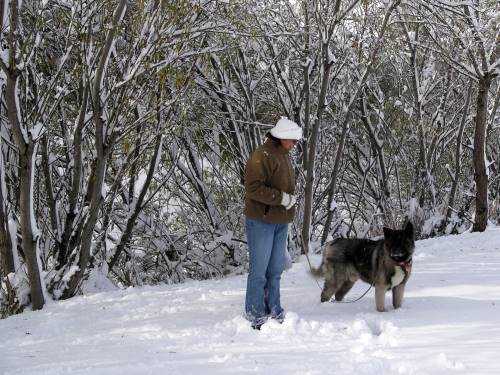
Saturday Night Cooking Club
Wednesday, November 14, 2007, 6:33 PM GeneralPosted by stefanie Since our first trip to Father Hige's restaurant, we've kind of become regulars there. We'll drop by after work every so often for a drink, some really good cooking, and an animated chat at the bar. On Saturday night, we went there again with some friends. After a couple of hours of joking banter, talk naturally turned to Japanese food. I mentioned that I Ioved cooking, and that as part of my culinary explorations, I was going to begin making nuka-zuke (rice bran pickles) the next day. First, however, I needed to obtain some seaweed to go in the pickling mash. Much to my surprise, Hige-oyaji kindly gave me a big piece of the necessary seaweed, along with a piece of a different type of the same seaweed. He and one of our friends then proceeded to give me a tutorial on cooking nabe (hotpot dishes) with it, complete with little drawings. At the same time, Matthew and another member of our group were involved in an intense discussion about the proper vessel for shio-zuke, or salt pickling. Shio-zuke, our companions had explained, is the traditional Tohoku pickling technique ¡½ rice bran pickling is more common in the Kanto (greater Tokyo area, generally) and Kansai (area including Kyoto and Osaka) regions. Wooden tubs are needed for proper salt-pickling because they encourage the right kind of fermentation. Using a synthetic tub just gets you salty vegetables. Today, the nuka-zuke bed is in its fourth day of development. Thanks to our friends, we'll also be exploring shio-zuke and nabe soon.
Friday, November 2, 2007, 3:56 AM GeneralPosted by matthew Is there anything you're planning to do "someday"?
Last May, we traveled to northern Japan. It was an amazing experience, and afterwards we sometimes talked about the possibility of moving there. Then, in October, we decided we would actually do it — "someday".
That "someday" was comforting. No hurries, nothing that needed to be done right then. We had plenty of time to get our affairs in order, save money, and prepare ourselves. We were able to think of ourselves as bold, adventurous people — "We made this momentous decision!" — without having to actually do anything about it.
Just a few days later, a year ago today, everything changed. Life presented us with a crossroads, and forced us to make a choice. It was time to really commit, if we were seriously going to do this.
But what if that hadn't happened? Where would we be today? Would we still be in Maryland, making our plans to move to Japan "someday"? Would that "someday" ever have come?
If we could do something when we had to make a choice, why couldn't we do it without life forcing the issue? What were we waiting for?
What are you waiting for?
[ add comment ] permalink
Friday, November 2, 2007, 3:20 AM GeneralPosted by stefanie "If you're gonna jump, then jump far." ¡½ Natasha Bedingfield, contemporary British philosopher
Having a comfortable life means having a place to stand, and room to maneuver. It means walking around, dodging obstacles, and sitting down with a drink in your hand at the end of the day. It means home, stability, refuge. You might go near the edge, but you don't jump.
But when the ground starts to crumble under your feet, you have two options. You can step back to safety, or you can jump.
One year ago today, we decided to jump.
[ 3 comments ] permalink
On Sunday, we took advantage of the fine fall weather to make an excursion on the Kitakami Line. This railroad crosses the central mountains of Japan, traveling between Kitakami and Yokote (in Akita Prefecture). Running along steep hillsides and across mountain valleys, it offers spectacular views — especially in autumn, when the leaves are changing. In Kitakami, some fall colors are starting to show, but as we ascended it became clear the leaves were much further along in the mountains. Exiting the first tunnel into a mountain valley, the change in view was so startling that everyone on the (somewhat crowded) train gasped. 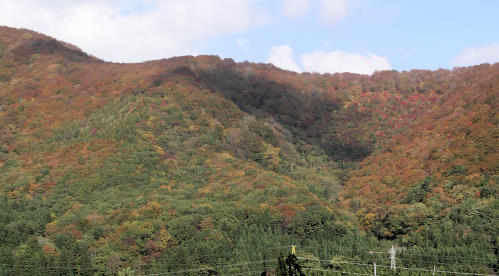 We were in and out of tunnels most of the way, with plenty of breathtaking scenery in between. Sometimes the colors were brightest on the hillside near the train. 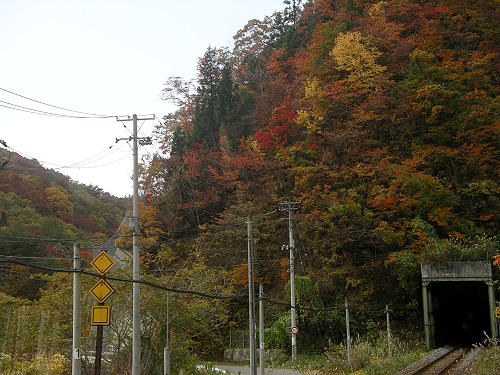 Other times, it was the view across a valley that was spectacular. 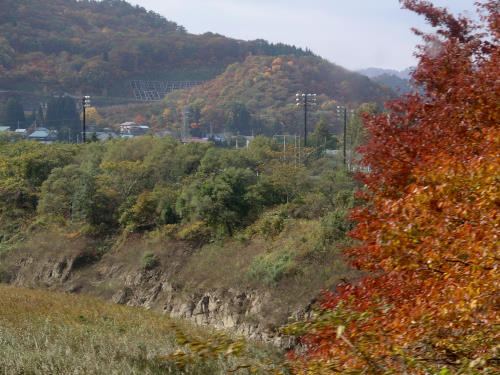 At the end of the line, we took a couple of hours to walk around Yokote. Brightly colored trees shared the view with Yokote Castle. 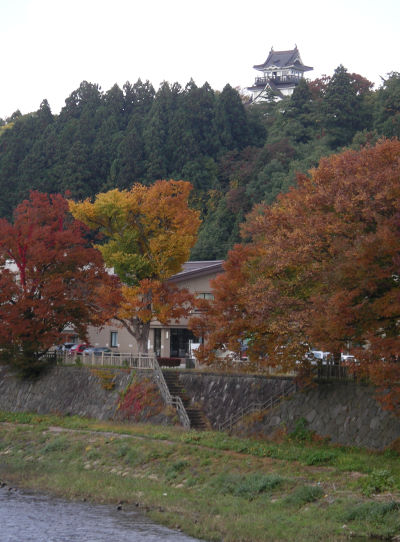 We left Yokote in the early afternoon so we'd have time to stop in Hotto Yuda, an onsen (hot spring) village along the way. There's even an onsen inside the railroad station! The town is on the shores of a mountain lake, in an area justly famous for the turning leaves. 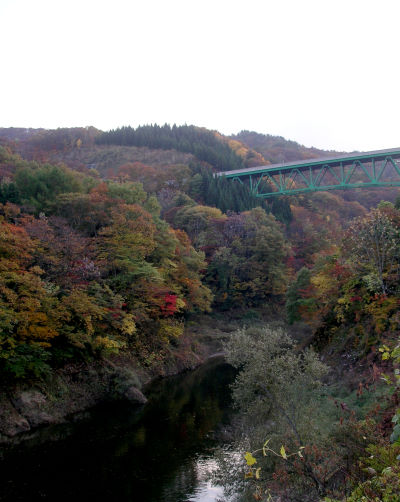 We enjoyed a soak in the spring (more on that later), then returned home, refreshed but exhausted.
Wednesday, October 31, 2007, 1:57 AM GeneralPosted by stefanie Public baths can be daunting to foreigners because of the language barrier and the unwritten etiquette. We visited plenty of public baths during our vacation last year, but I still get nervous about inadvertently breaking one of the rules. And my nascent language skills aren't quite up to the challenge of conversing about the finer points of public bathing. So our Sunday onsen (hot spring bath) visit left me feeling both extra clean and a bit confused.
We know the public bath drill. First, you wash your hair and body at a separate wall of spigots, using a large washcloth. After washing, you can soak as long as you like in the hot baths. Once you're done bathing, you shower off again before returning to the dressing room. It's all very civilized and quite enjoyable after you get past the "roomful of naked people" aspect.
I followed the drill: washing, soaking, contemplating. When I felt adequately onsened, I headed back to the spigots, but my spot near the soap was occupied. No matter. I figured I'd cool off with a soap-free rinse at another spigot. The woman next to me offered me some of soap she had brought. I told her that I was quite daijoubu, but thanks. And then she offered the soap again, with a kind (tolerant?) smile and a "kudasai."
Crap. "Kudasai" always makes me nervous because it's used for requests and I often don't know how to read the request. Did she mean "please, feel free to use my soap"? Or did she mean "No, seriously, it's completely unacceptable to not use soap after bathing. Don't you know the rules?" Not wanting to offend, I gave a very formal thank you and lathered up my oversized washcloth, desperately trying to remember whether I was supposed to use soap after soaking in the bath.
Next time, I'm taking my own soap.
[ 3 comments ] permalink
Something Old, Something New
Sunday, October 21, 2007, 8:22 PM GeneralPosted by stefanie On my way to Japanese class last week, I was stopped at a traffic light. An older woman, hunched over a kind of rolling walker thing, slowly crossed the street as cars waited. She wore the wide-brimmed hat, jacket, and knee-high rubber boots indicative of rice farmers; I presumed her bent posture was the result of years spent working in the paddies. When the light changed and traffic began to move, I caught a glimpse of accelerating white movement out of the corner of my eye. A Yamabiko shinkansen was leaving Kitakami Station, on its way north to Morioka. So it is in Tohoku, frequently described in tourist literature as one of the last remaining places to find "Old Japan." The past and the future collide on a daily basis here.
[ add comment ] permalink
Tuesday, October 16, 2007, 9:22 PM GeneralPosted by stefanie Closed doughnut shop notwithstanding, Sunday's road trip went off without a hitch. The staff at the Kitakami Mister Donut were kind enough to open a few minutes early (to quote the tape on my pumpkin muffin wrapper: "Thanks, you beautiful people!"). We got our road snacks and set off on our journey to the north. Matthew has been in touch with a local model railroading group that ran a layout this weekend in Hachinohe, Aomori Prefecture. Aomori-ken is our neighbor to the north; Hachinohe is a mere 2-1/2 hour drive away, on the coast. Fans of our previous road trip stories may be disappointed to learn that the Hachinohe installment of The Road Ahead had none of the prior narrow roads, high curving bridges, ditches, or freakout sessions. In fact, the trip was blissfully peaceful and beautiful, with the mountains beginning to show fall colors in spots. We also got our first look at Iwate-san, the tallest mountain in the prefecture. It's HUGE! I left Matthew at the Hachinohe City Museum, where the show was being held, and went exploring. The museum is next door to Nejo Plaza, a castle compound built in 1334 by Lord Moroyuki Nanbu. Many buildings within the plaza have been restored, and it's quite fascinating to walk through. Especially the workshops and storage areas, which have thickly thatched rooves made from reeds that hang quite low, such that you have to crouch and duck to get inside (the recordings telling you about the buildings also exhort you to watch your head as you leave). It's interesting to me that many buildings of that era appear to have been constructed from a material much like the adobe used in New Mexico ¡½ a mixture of mud and straw of some sort. I don't have photos because we only have one camera and someone needed it to take photos of trains. Hmph. With time left before the end of the show, I went downtown to check out more of Hachinohe. To no one's surprise, I found a liquor store. We can't travel without acquiring booze, so I asked after Hachinohe local sake and was given samples from one brewer. According to the liquor store guy, the drier one I preferred was otoko no sake, a "man's sake." Indeed. I assured him that my husband would be drinking it, and went on my merry way, beautiful sake bottle in hand. After the show, Matthew and I dined on some of the local seafood for which Hachinohe is known (squid sashimi for him, grilled fish for me) and made our way back to Kitakami and the dogs. The dogs seemed kind of miffed that we went off for doughnuts, fish, and adventures without them. They got over it when we fed them.
[ add comment ] permalink
Monday, October 8, 2007, 2:01 AM General, DogsPosted by stefanie Overheard in the park today while walking the dogs.
Adorable 3-year-oldish Japanese child looking at Moki: Ookii kuma! (Translation: Big bear!)
Child's amused mom: Inu da, yo. (Translation: That's a dog, actually.)
Incidentally, the big bear decided to eat a couple of green tea bags later in the day without our knowledge. At least he'll have a healthy immune system.
[ 4 comments ] permalink
Back Next
|
|






 Calendar
Calendar




